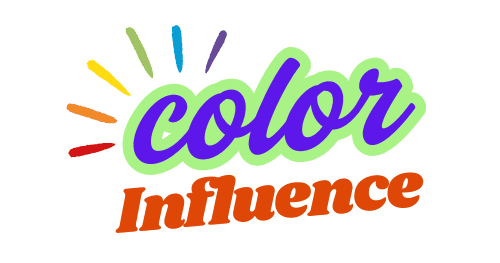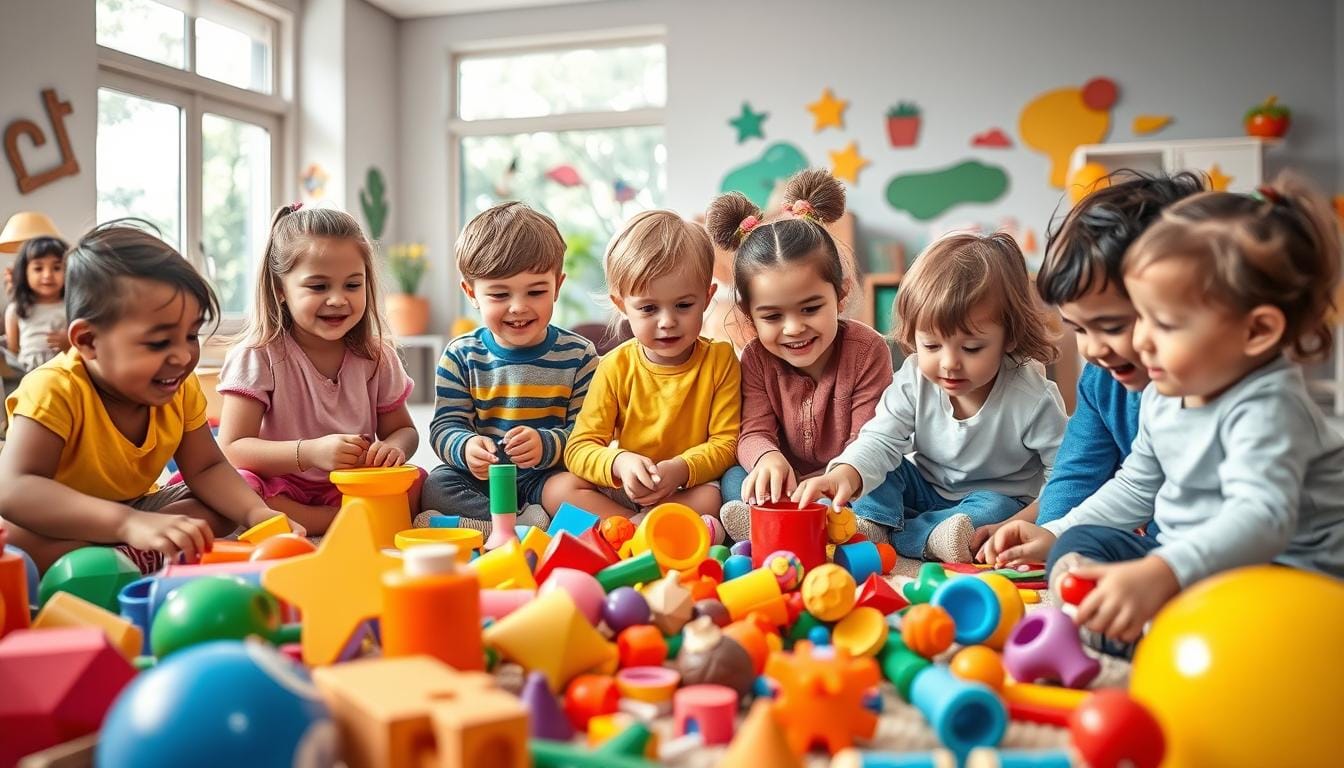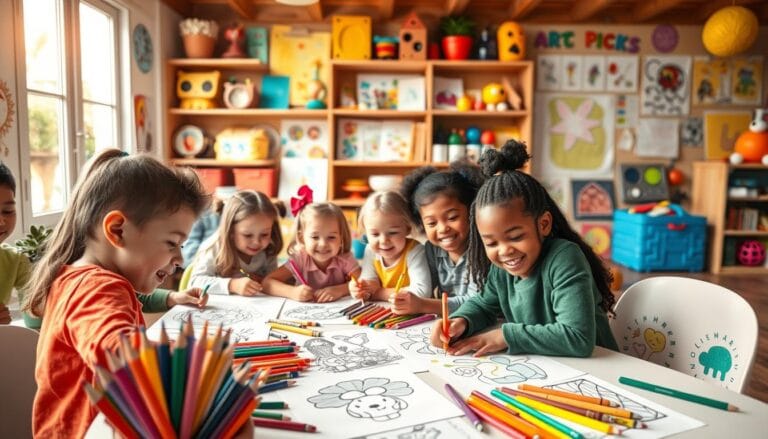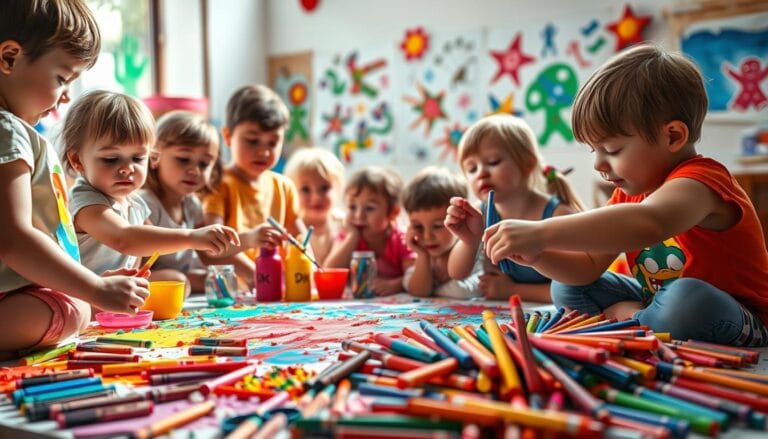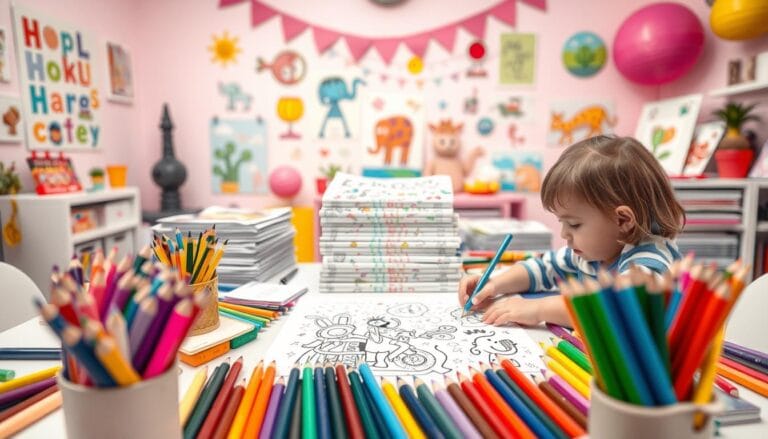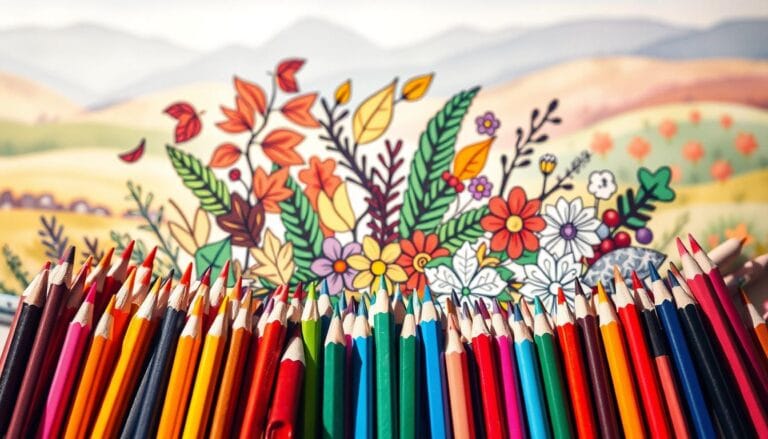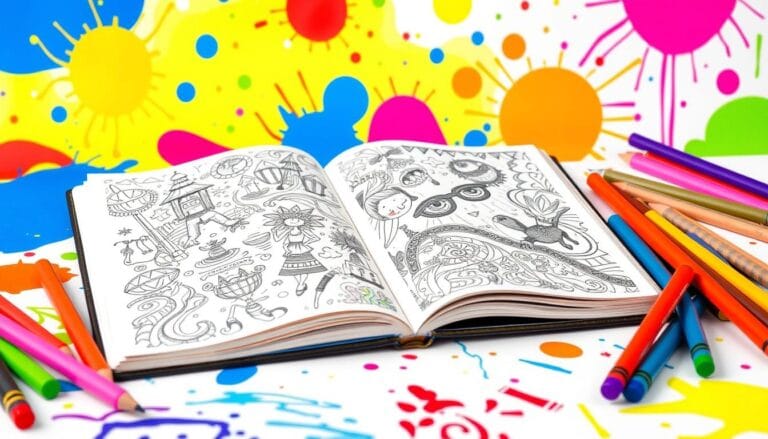Color Psychology in Children: How Colors Affect Learning and Behavior
Have you ever seen a child’s face light up with vibrant colors? As a parent and educator, I’ve seen how colors change learning and feelings. Colors are more than just what we see; they talk to our minds and hearts.
Exploring how kids see colors opens a world where each color has its own story. Kids see colors more intensely than adults, feeling them deeply. Colors like blue calm them, while red makes them energetic.
Colors do more than just catch our eye. They affect our mood, how we behave, and even how we solve problems. Knowing this, we can make learning spaces better for kids.
Understanding the Fundamentals of Color Psychology in Children
Colors are fascinating for kids and how they see the world. A child’s color perception starts early and grows as they get older. It’s a mix of seeing and feeling colors.
Color science for kids shows how young minds handle colors. It’s not just about seeing colors. It’s key for learning and feeling emotions.
The Science Behind Color Perception
Children’s color vision grows in stages. Their brains change a lot in early years. Here are some important points:
- Infants see mainly black and white at first
- As they get older, primary colors become more interesting
- By age 5, they really start to recognize colors
How Children Process Colors Differently
Young brains see colors in their own way. Studies show kids have special ways to process colors:
| Age Group | Color Perception Characteristics |
|---|---|
| 0-12 months | Prefer high-contrast patterns |
| 1-3 years | Drawn to bright, primary colors |
| 4-7 years | Develop emotional color associations |
The Role of Colors in Early Development
Colors are more than just what we see. They help kids learn and understand feelings. About 90% of what we judge about places comes from color. This shows how important colors are for kids.
“Colors speak a language that children understand before words” – Child Development Experts
Knowing how kids see colors helps parents and teachers. It lets them make better learning spaces. These spaces help kids grow in many ways.
The Impact of Warm Colors on Child Behavior
Colors have a big impact on kids’ feelings and actions. Warm colors like red, yellow, and orange change how kids see and feel their world. Knowing how colors affect kids helps parents and teachers make better spaces for them to grow.
Warm colors stir up feelings and certain reactions in kids. Studies show interesting ways these bright colors affect young minds.
Red: Energy and Attention
Red is a lively color that can really change a kid’s energy. It can make them more focused and eager, but too much can be too much. Here are some key things about red:
- Increases heart rate and alertness
- Potential to improve focus in short bursts
- Risk of causing restlessness if overused
Yellow: Creativity and Optimism
Yellow is a color that makes people feel better and more creative. Studies show yellow can:
- Boost happiness and cheerfulness
- Stimulate mental activity
- Encourage optimistic thinking in children
“Colors speak a language more profound than words, especially for children.” – Color Psychology Expert
Orange: Social Interaction and Confidence
Orange is a color that helps kids feel more confident and ready to connect with others. Its warm, welcoming vibe makes kids feel:
- Confident in social situations
- Comfortable expressing themselves
- Enthusiastic about group activities
Using warm colors in kids’ areas needs careful thought. The right amount and placement can bring out the best in kids without overwhelming them.
Cool Colors and Their Calming Effects
Explore the amazing world of cool colors and their big impact on kids’ feelings and learning. Colors like blue, green, and purple have special calming effects.
Blue is a top choice for calm in child development. Studies show it can lower anxiety and make kids feel safe. A blue bedroom instantly turns into a peaceful haven.
“Colors speak a language more powerful than words, especially for children.” – Color Psychology Expert
- Blue: Reduces stress and promotes relaxation
- Green: Symbolizes balance and emotional stability
- Purple: Stimulates creativity and imagination
Green, linked to nature, adds balance to kids’ spaces. It makes areas feel calm yet slightly exciting. Green can turn study spots into quiet places for learning.
Purple is a magical color that boosts kids’ creativity. It makes bedrooms and play areas into creative worlds. Lighter purple shades help kids feel emotionally stable and support their learning.
When making spaces for kids, think about cool colors’ power. They’re not just for looks; they help kids feel better and learn more.
Color Psychology in Learning Environments
Creating the perfect learning environment involves choosing colors wisely. This supports children’s psychological and educational needs. Color and child psychology are key in designing spaces that boost learning, creativity, and focus.
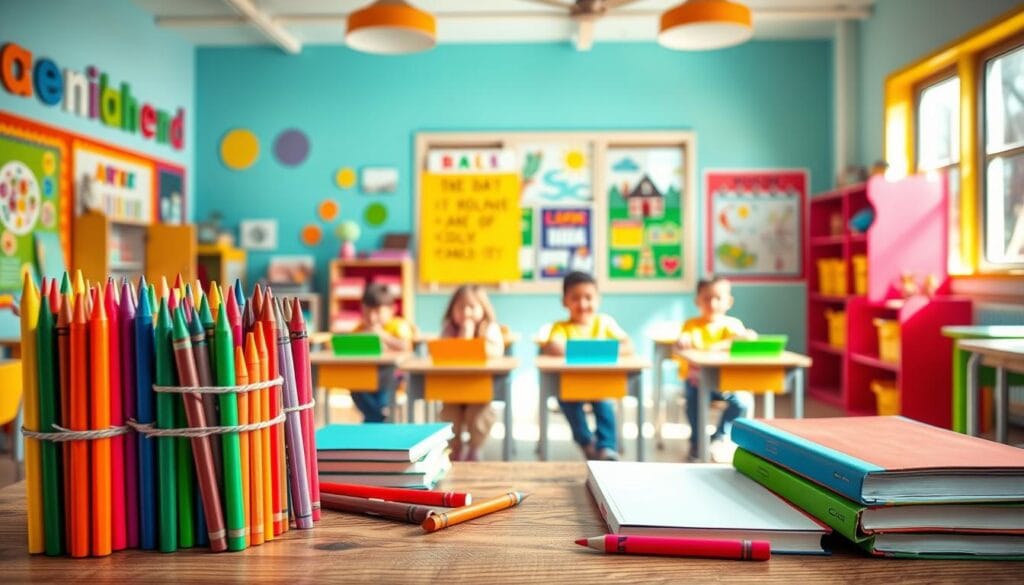
Educational settings can change student experiences with careful color choices. Research shows that certain colors can greatly affect learning outcomes and emotional well-being.
Classroom Color Schemes
Effective classroom design uses colors that support different learning activities. Here are key considerations:
- Use 2-3 colors in smaller spaces
- Select 4-6 colors for larger areas like cafeterias
- Balance stimulating and calming color tones
Study Areas and Focus Zones
Color choices can greatly affect concentration and academic performance. Consider these research-backed recommendations:
| Color | Learning Impact | Recommended Use |
|---|---|---|
| Blue | Improves productivity | Study areas, libraries |
| Green | Reduces eye strain | Reading corners |
| Yellow | Enhances concentration | Creative subjects |
Creative Spaces and Play Areas
Vibrant colors can spark imagination and energy in learning environments. Yellows and oranges create friendly atmospheres that boost learner engagement. Greens and blues help with information processing.
“Colors speak a language more powerful than words, especially in educational spaces.” – Color Psychology Expert
Remember, individual differences matter. Letting students choose colors can make them feel more at home in the classroom.
The Role of Color in Emotional Development
Color psychology is key in a child’s emotional growth. Young minds react strongly to colors, with each hue evoking different feelings. Knowing these connections helps parents and teachers boost kids’ emotional smarts.
Studies show how colors affect kids’ emotions. Warm colors like red and orange make them feel energetic and excited. Cool colors, such as blue, calm them down. Blue is especially good at easing anxiety and bringing peace.
- Red: Stimulates attention and increases heart rate
- Blue: Reduces stress and creates a sense of peace
- Green: Promotes feelings of balance and harmony
- Yellow: Encourages happiness and creativity
“Colors speak a language more profound than words, especially for children learning to understand their emotions.” – Child Psychology Research Institute
Children use colors to express their feelings. Art therapy shows how color choices can show a child’s emotional state. Bright colors show joy, while soft colors show quieter feelings.
Parents can use color psychology to support their kids. Choosing the right colors for rooms can help a child’s mood and growth. This can be in bedrooms, playrooms, or learning areas.
Keep in mind that color preferences change as kids grow and have new experiences. What excites one child might overwhelm another. So, it’s important to tailor color choices to each child’s emotional needs.
Color Preferences Across Different Age Groups
Exploring how children see and understand colors is really interesting. As kids get older, their color perception changes a lot. This shows us how young minds work with what they see.
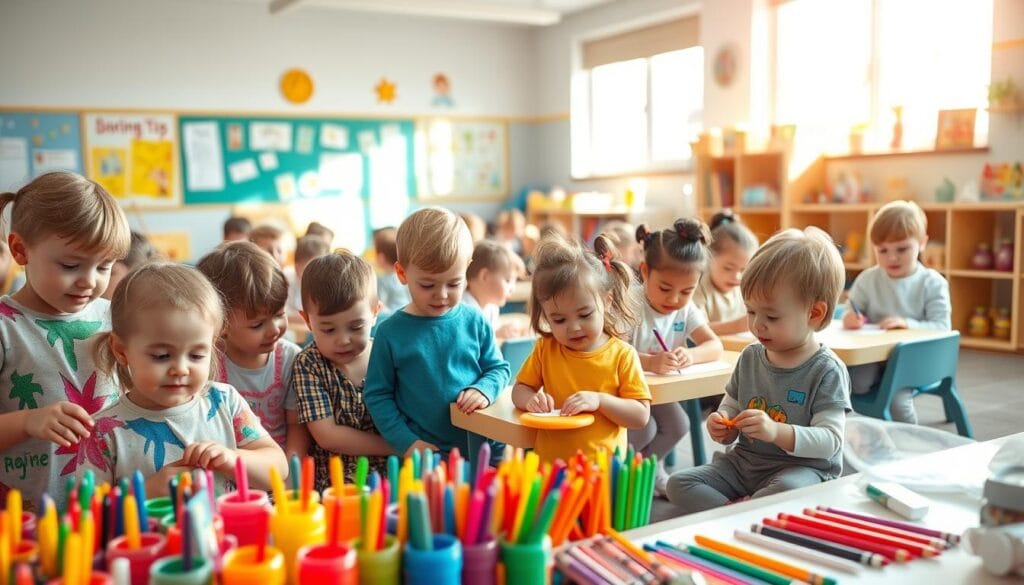
Infant Color Recognition
Newborns can only see a few colors at first. Studies show they like black and white the most. As they grow, they start to enjoy more colors.
- High-contrast patterns help babies see better
- By 3-6 months, bright colors like red, blue, and yellow catch their eye
- These colors are easy for young eyes to see
Toddler Color Preferences
Toddlers love bright, bold colors. These colors grab their attention and help them learn. They also help kids tell objects apart and learn new words.
“Colors are children’s first language of imagination” – Unknown
School-Age Children’s Color Choices
Older kids start to pick colors that are more their own. Research shows some interesting things about color choices:
- Boys often like darker colors more
- Girls tend to like colors that are more vibrant
- What color a child likes can tell us about their feelings
A study with 309 kids aged 10-14 showed how color choices change. These changes show both what kids like personally and how they are influenced by others.
Using Color to Enhance Memory and Learning
Color is key in learning strategies for kids. Studies show how colors can boost memory and brain work.
Color therapy for kids means knowing how colors affect the brain. The Von Restorff Effect shows that bright colors help us remember better than plain ones.
“Colors are not just visual experiences, they are cognitive tools that can unlock learning potential.” – Neuroscience Research Institute
- Red enhances focused memory and attention to details
- Blue promotes calm problem-solving and long-term information retention
- Green reduces mental fatigue during study sessions
- Yellow boosts motivation and short-term memory
Using a color-coding system can change how kids learn. For example, mark important facts in red, creative ideas in blue, and examples in green.
| Color | Learning Impact | Recommended Use |
|---|---|---|
| Red | High Attention | Highlight Important Information |
| Blue | Calm Concentration | Complex Problem Solving |
| Green | Sustained Attention | Extended Study Sessions |
| Yellow | Short-Term Memory | Motivational Learning |
Knowing about color psychology helps create better learning spaces. These spaces support kids’ brain growth and memory.
Cultural and Gender Influences on Color Perception
Color perception is more than just seeing colors. It’s about how culture and gender shape our feelings and thoughts. Understanding how children see colors means looking into these big influences.
How kids see colors changes a lot based on their culture. Each society has its own color meanings. These meanings shape how children grow and learn.
Cultural Color Symbolism
Colors mean different things in different parts of the world. For example:
- Western cultures often see white as pure
- In Eastern cultures, white can mean mourning
- Red is lucky in Chinese traditions
- Green is about growth and harmony in many Islamic cultures
Breaking Color Gender Stereotypes
Color choices can be limited by old ideas about gender. Studies show 40% of kids in Western cultures pick colors based on gender. This limits how they can express themselves.
“Colors should inspire creativity, not restrict potential.”
Diversity in Color Applications
| Cultural Context | Color Preference | Psychological Impact |
|---|---|---|
| Western Cultures | Blue (40% preference) | Calmness, Stability |
| Eastern Cultures | Red (Symbolic luck) | Excitement, Energy |
| Multicultural Approach | Diverse Color Palette | Inclusive Emotional Development |
Seeing colors in many ways helps kids grow emotionally and understand cultures better. By breaking free from old color rules, we make spaces where everyone can be themselves.
Conclusion
Color psychology in children opens up a world of emotional and cognitive potential. The right colors can change learning spaces, helping kids grow and feel better. Color is more than looks; it’s a key tool for young minds.
Studies show that the right colors can make kids behave better, think creatively, and manage their feelings. Blues calm kids in study areas, while yellows boost creativity in play spaces. Each color has its own role in shaping kids’ experiences.
Creating spaces with color psychology is all about balance and watching how kids react. By choosing colors wisely, you can make places that inspire learning and meet kids’ needs. This is true for classrooms, playrooms, or bedrooms.
Color is a powerful tool for kids’ development. By exploring color psychology, you can open new doors for learning, emotional growth, and self-expression. Your color choices today can shape confident, creative, and emotionally smart kids for tomorrow.
FAQ
How do colors affect a child’s mood and behavior?
Colors can really change how a child feels and acts. Warm colors like red can make kids more energetic and focused. Cool colors like blue can help them relax.
Each color can make kids feel different ways. This can affect their mood, how well they concentrate, and their emotions.
At what age do children start recognizing colors?
Infants start to see basic colors around 4-6 months. By 18 months, they can name some colors. Between 3-5 years old, they really get colors.
Can color improve a child’s learning process?
Yes, colors can make learning better. They help kids remember things, stay focused, and make learning fun. Using colors in study materials can help kids learn and remember better.
How do cultural backgrounds impact color perception in children?
Culture really shapes how kids see and feel about colors. Different cultures mean different things by colors. This can affect how kids feel and think about certain colors.
Are there any negative effects of using too many colors?
Too many colors can be overwhelming. It might make kids less focused, more anxious, or feel too much. It’s key to use colors in a way that helps kids learn and feel good.
How can parents use color psychology to support their child’s development?
Parents can use color psychology to help their kids. They can pick colors that match what their kids need. For example, calm blues in bedrooms or bright yellows in play areas.
Do color preferences change as children grow?
Yes, kids’ color preferences change as they get older. Babies like high-contrast colors, toddlers like bright colors, and older kids have more complex tastes.
How can colors help children express emotions?
Colors are great for kids to show their feelings, especially in art. They can express emotions they can’t put into words. This helps kids understand and manage their feelings better.
Are there gender-specific color preferences?
While some think pink is for girls and blue is for boys, it’s not true. Kids really like what they like, and colors shouldn’t be just for boys or girls.
How do different colors impact concentration and focus?
Cool colors like blue and green help kids focus and stay calm. Warm colors like yellow spark creativity. But too much red can be too much.
